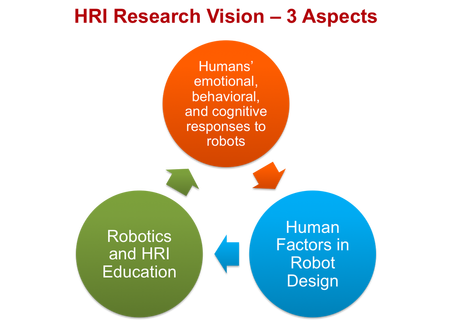About the Lab
You and Your Robot Coevolution Laboratory (Human-Robot Coevolution Laboratory) is my research lab that tracks my research on how humans evolve as their self-concept develops and matures, how robots evolve as technology advances to increase their capabilities, as well as how humans and robots influence each other. Humans and robots co-evolve through humans' exploration and learning about themselves and the world, interactions with each other, and humans use of human factors and all sorts of software and hardware development to improve robots. This appears at an individual level, but it is more salient at a scope of human and robot species over a life time and beyond. I have been researching on both humans and robots' development.
Over the past 10 years, I have worked most with people in Psychology, Education, Computer Science, and Mechanical Engineering. I am thankful for the experiences of working with many wonderful and talented people.
Over the past 10 years, I have worked most with people in Psychology, Education, Computer Science, and Mechanical Engineering. I am thankful for the experiences of working with many wonderful and talented people.
What is this website about?
|
This website is dedicated to present Lixiao and her team's research on Human-Robot Interaction (HRI): Responses, design, and education (see the figure to the right). On this website, you may find the following information:
|
Who may benefit from this website?
- Human-Robot Interaction Researchers
- Robotics education practitioners who would like to share or explore the development of a robotics team, learning process, and learning outcomes through research
- HRI education practitioners (professors, instructors)
- Robotics education and HRI education researchers who would like to learn from each other
- Students who are interested in a career path this is related to robotics
- Robotics tournament organizers who would like to evaluate their program through research
- Robotics hobbyists who are interested in HRI research
- Robotics companies who seek ways to improve their robot design or evaluate humans' responses to their robot products
A little history about this website
I started my doctoral study in Human Factors in Psychology department at NC State University in 2011. One day in 2012, I was wandering at the brickyard next to the D. H. Hill Jr. Library and saw a group of people demonstrating Lego robots. These robots can walk and turn around when they hit an obstacle, and they can also get back up when they fell down. I was amazed by what they can do. The group leader Dr. Varnado came to talk to me, explaining that these robots were built by students in her robotics education course. As we chatted, she mentioned that students had difficulty dismantling robots at the end of the semester when preparing the parts for new students in the coming semester. Dr. Varnado wondered why some students even cried. She was curious whether this was attachment, but she did not find any empirical research to support her observation. She said that she was longing to find someone to do this research. I happened to be looking for a research topic, so I said to her that I can help her. We happily agreed. It turned out that her class was at the first floor of Poe Hall, where my office was on the 7th floor of the same exact building. My PhD adviser Dr. Douglas Gillan encouraged me to pursue this line of research.
From then on, I did multiple studies with Dr. Varnado's student at her robotics education course and published multiple papers on human emotional attachment (later changed to responses) to their robots. Dr. Terri Varnado mentioned about robotics tournaments (e.g., FIRST, VEX) where I can find a large number of participants for my studies, so I extended my research to robotics tournaments until I graduated and joined Duke Robotics as a postdoc.
This personal website was originally created to interact with high school tournament robot builders as I distributed my business cards to more than 300 students and coaches as I reached out to them to fill out my surveys. They are the future of robotics. I wanted to document all the robotics events I have went for my research and academic growth to provide a reference about academic life of human-robot interaction research is like.
My postdoctoral work at Duke and current assistant research scientist position at Arizona State University provided access to a variety of robots and testbeds. This has broaden the span of my research and range of the audience of this website.
From then on, I did multiple studies with Dr. Varnado's student at her robotics education course and published multiple papers on human emotional attachment (later changed to responses) to their robots. Dr. Terri Varnado mentioned about robotics tournaments (e.g., FIRST, VEX) where I can find a large number of participants for my studies, so I extended my research to robotics tournaments until I graduated and joined Duke Robotics as a postdoc.
This personal website was originally created to interact with high school tournament robot builders as I distributed my business cards to more than 300 students and coaches as I reached out to them to fill out my surveys. They are the future of robotics. I wanted to document all the robotics events I have went for my research and academic growth to provide a reference about academic life of human-robot interaction research is like.
My postdoctoral work at Duke and current assistant research scientist position at Arizona State University provided access to a variety of robots and testbeds. This has broaden the span of my research and range of the audience of this website.

